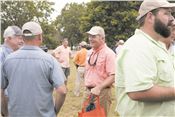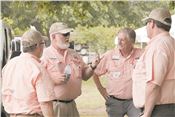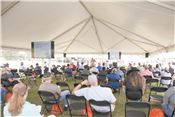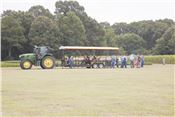Live Milan Field Day A Hit This Year
BETTY VALLE GEGG-NAEGER
MidAmerica Farmer Grower
MILAN, TENNESSEE
A light rain in the morning didn’t deter the crowd that gathered at the Milan No-Till Field Day recently, according to Blake Brown, Director of the UT Ag Research & Education Center there. After several years of virtual presentations, farmers were anxious to get out and visit the station, observe the presentations first-hand and shake hands with other farmers and researchers alike.
The field day went virtual in 2020, and while growers eagerly sought out the information presented, the program lacked the comradery experienced when farmers meet face-to-face and share production information among each other and the researchers.
“We’re really happy to be back live and to have people here on site,” said Brown. “We had a great turnout in 2020 and we reached many folks, but it just wasn’t on-site, so it’s nice to have it back now. I think farmers are ready to get back.”
A great program was planned this year, although it differed from previous in-person events.
“In 2018, we took the field day all over the center,” Brown explained. “One unique thing about our center, we have four tracts of land. Two of them are leased from the United States Army and we can’t take people there. So we were limited in just what we could actually show. We learned in 2020 by going virtual we could take them to places virtually that we couldn’t go to otherwise, so when we first discussed this event, whether to go virtual again or go live – there are plusses and minuses both ways – and we debated it back and forth for months.”
Then, at a meeting of the Tennessee Corn Growers where Brown spoke, he was asked about plans for the field day. “One grower there said: Do you know why I come to these meetings? To see all my buddies.”
Brown realized then that the social part is huge; and the committee planning the event was discounting that.
“What if we do a hybrid?” Brown suggested to them.
So they combined the in-person event with virtual opportunities.
“We’re not taking people all over just this north tract, we’re taking them all over the entire center virtually; and across the state to our other centers. So we’re getting the best of both worlds, we hope.”
The tours were centered around three big tents at the station as well as the museum conference room. There were four locations with tours there every hour in each of those locations, so everyone had the chance to see those, and all the content is available online as well.
“We have our trade show here, we have our museum tours, we have an overview tour of the station, but it’s all consolidated more in this general area than it’s ever been,” Brown noted. “So it’s good to have everybody here together.
While he hadn’t personally been to the programs to see the interaction, he felt the transfer of information, questions and answers were bound to be better than the past programs.
“We would typically put people on a bus or trailer here and haul them a half or three-fourths mile away, but right here, it’s all here. You can see everything from wherever you are, you can see the trade shows from the research tents. There’s a big food tent in the middle providing food. I just can’t help but think from that standpoint it’s got to be better.”
As a research station, programs are tried, and if they don’t work or methods can be improved, organizers back up and try something else.
Many people were gathered around the exhibitor tents all of which were large enough to handle the group. Large TVs displayed the presentations for the crowds who couldn’t get close enough.
“We were Amazon’s best customers,” Brown explained. “We ordered seven or eight 75-inch TVs. That’s just a commitment we made to do as best we can. It gives the speakers more flexibility to deliver their messages.”
Despite having 10 people out with Covid in the previous week, organizers did a great job making last minute changes in speakers.
“We will evaluate when it’s all over, we will meet with all of my staff and discuss what worked well and what didn’t work well,” Brown continued. “And I really want to know what didn’t work well, because we’re always trying to make it a little bit better.”
While the previous 40 years generally ran smoothly, there always are some hiccups.
“Our goal is to get the best possible unbiased research information to our producers. The only thing we produce at these research stations is information,” is his take-home message.
After studying the statistics on the interest shown for this year’s event, Brown had the following comments:
“We were excited to be back live for the first time since 2018 and managed to produce a hybrid field day that was both live and virtual.
We were pleased to welcome 1,212 visitors from 14 states and 45 Tennessee counties. The comments we have received have been overwhelmingly positive! As of Aug. 2, data from our virtual sites include 2,221 views and 29,025 impressions from our YouTube channel; 7,172 Pageviews from our No-Till Field Day website; and 13,609 Facebook Reaches and 1,086 Facebook Likes. These data confirm that the event has been and will continue to be a success.”
Online reports of the program are available at milannotill.tennessee.edu ∆
BETTY VALLE GEGG-NAEGER: Senior Staff Writer, MidAmerica Farmer Grower
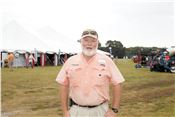
Center Director Blake Brown says the Milan No-Till Field Day has hosted visitors from across the country and around the world to the
largest field day in the nation dedicated to conservation tillage since 1981.
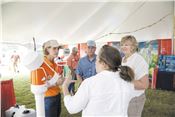
Members of AgLaunch at the Milan No-Till Field Day are (L to R) Carrie Castille, Sr. Vice Chancellor and Sr. Vice President; Tom Womack, Sr. Advisor; Margaret Oldham, Director of Entrepreneurship and Rebecca Kaufman, Sr. Director. To the extreme left is GroGuru, one of Ag Launchs portfolio companies that has gone through their startup accelerator program and is field testing their irrigation management systems though their farmer network.
Photos by John LaRose, Jr.
